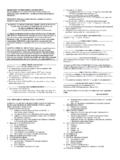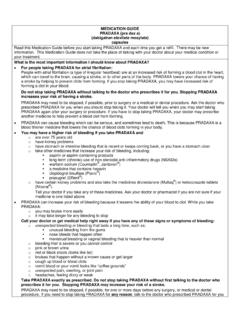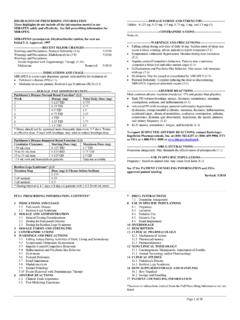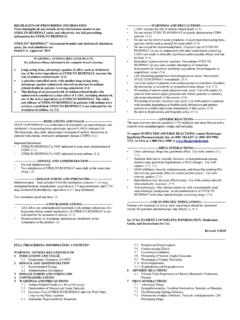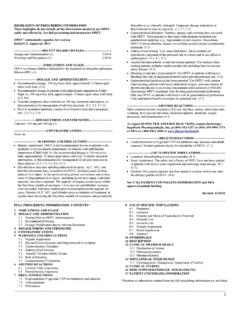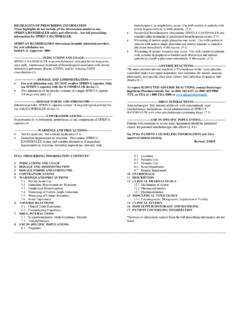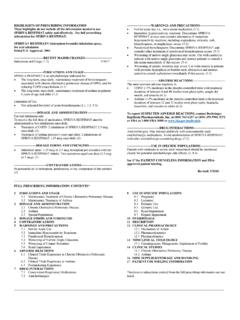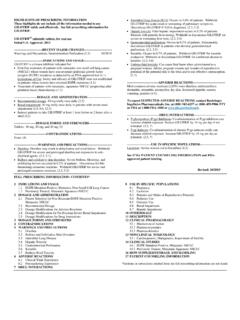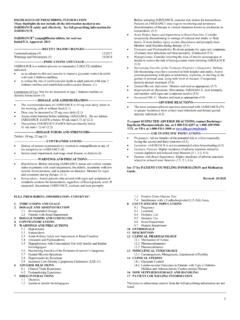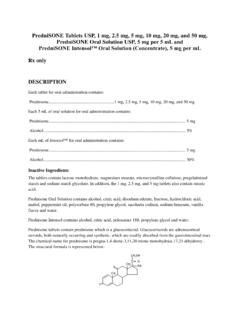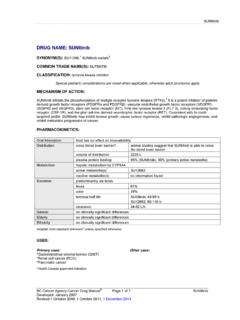Transcription of MICARDIS -----------------------WARNINGS AND …
1 HIGHLIGHTS OF PRESCRIBING INFORMATION These highlights do not include all the information needed to use MICARDIS safely and effectively. See full prescribing information for MICARDIS . MICARDIS (telmisartan) tablets, for oral use Initial Approval: 1998 WARNING: FETAL TOXICITY See full prescribing information for complete boxed warning. When pregnancy is detected, discontinue MICARDIS as soon as possible ( , ) Drugs that act directly on the renin-angiotensin system can cause injury and death to the developing fetus ( , ) ----------------------------INDICATIONS AND USAGE--------------------------- MICARDIS is an angiotensin II receptor blocker (ARB) indicated for: Treatment of hypertension, to lower blood pressure.
2 Lowering blood pressure reduces the risk of fatal and nonfatal cardiovascular events, primarily strokes and myocardial infarctions. ( ) Cardiovascular (CV) risk reduction in patients unable to take ACE inhibitors ( ) ----------------------DOSAGE AND ADMINISTRATION----------------------- May be administered with or without food ( ) When used for cardiovascular risk reduction, monitoring of blood pressure is recommended, and if appropriate, adjustment of medications that lower blood pressure may be necessary ( ) Indication Starting Dose Dose Range Hypertension ( ) 40 mg once daily 40 to 80 mg once daily Cardiovascular Risk Reduction ( ) 80 mg once daily 80 mg once daily ---------------------DOSAGE FORMS AND STRENGTHS---------------------- Tablets.
3 20 mg, 40 mg, 80 mg (3) -------------------------------CONTRAIND ICATIONS------------------------------ Known hypersensitivity ( , anaphylaxis or angioedema) to telmisartan or any other component of this product (4) Do not co-administer aliskiren with MICARDIS in patients with diabetes (4) -----------------------WARNINGS AND PRECAUTIONS------------------------ Avoid fetal or neonatal exposure ( ) Hypotension: Correct any volume or salt depletion before initiating therapy. Observe for signs and symptoms of hypotension ( ) Monitor carefully in patients with impaired hepatic ( ) or renal function ( ) Avoid concomitant use of an ACE inhibitor and angiotensin receptor blocker ( ) ------------------------------ADVERSE REACTIONS------------------------------- Hypertension: The most common adverse events ( 1%) reported in hypertension trials are back pain, sinusitis, and diarrhea ( ) Cardiovascular risk reduction: The serious adverse events ( 1%) reported in cardiovascular risk reduction trials were intermittent claudication and skin ulcer ( ) To report SUSPECTED ADVERSE REACTIONS, contact Boehringer Ingelheim Pharmaceuticals, Inc.
4 At (800) 542-6257 or (800) 459-9906 TTY, or FDA at 1-800-FDA-1088 or ------------------------------DRUG INTERACTIONS---------------------------- --- NSAIDs: Increased risk of renal impairment and loss of anti-hypertensive effect (7) Do not co-administer aliskiren with MICARDIS in patients with diabetes (7) -----------------------USE IN SPECIFIC POPULATIONS------------------------ Lactation: Do not breastfeed during treatment with MICARDIS ( ) Geriatric Patients: No overall difference in efficacy or safety vs younger patients, but greater sensitivity of some older individuals cannot be ruled out ( ) See 17 for PATIENT COUNSELING INFORMATION and FDA-approved patient labeling. Revised: 02 /2018 _____ FULL PRESCRIBING INFORMATION: CONTENTS* WARNING: FETAL TOXICITY 1 INDICATIONS AND USAGE Hypertension Cardiovascular Risk Reduction 2 DOSAGE AND ADMINISTRATION Hypertension Cardiovascular Risk Reduction 3 DOSAGE FORMS AND STRENGTHS 4 CONTRAINDICATIONS 5 WARNINGS AND PRECAUTIONS Fetal Toxicity Hypotension Hyperkalemia Impaired Hepatic Function Impaired Renal Function Dual Blockade of the Renin-Angiotensin-Aldosterone System (RAS) 6 ADVERSE REACTIONS Clinical Trials Experience Postmarketing Experience 7 DRUG INTERACTIONS 8 USE IN SPECIFIC POPULATIONS Pregnancy 8.
5 2 Lactation Pediatric Use Geriatric Use Hepatic Insufficiency 10 OVERDOSAGE 11 DESCRIPTION 12 CLINICAL PHARMACOLOGY Mechanism of Action Pharmacodynamics Pharmacokinetics 13 NONCLINICAL TOXICOLOGY Carcinogenesis, Mutagenesis, Impairment of Fertility 14 CLINICAL STUDIES 14 .1 Hypertension Cardiovascular Risk Reduction 16 HOW SUPPLIED/STORAGE AND HANDLING 17 PATIENT COUNSELING INFORMATION *Sections or subsections omitted from the full prescribing information are not listed. _____ 2 FULL PRESCRIBING INFORMATION WARNING: FETAL TOXICITY When pregnancy is detected, discontinue MICARDIS as soon as possible [see Warnings and Precautions ( ) and Use in Specific Populations ( )].
6 Drugs that act directly on the renin-angiotensin system can cause injury and death to the developing fetus [see Warnings and Precautions ( ) and Use in Specific Populations ( )]. 1 INDICATIONS AND USAGE Hypertension MICARDIS is indicated for the treatment of hypertension, to lower blood pressure. Lowering blood pressure reduces the risk of fatal and nonfatal cardiovascular events, primarily strokes and myocardial infarctions. These benefits have been seen in controlled trials of antihypertensive drugs from a wide variety of pharmacologic classes including the class to which this drug principally belongs. Control of high blood pressure should be part of comprehensive cardiovascular risk management , including, as appropriate, lipid control, diabetes management , antithrombotic therapy, smoking cessation, exercise, and limited sodium intake.
7 Many patients will require more than one drug to achieve blood pressure goals. For specific advice on goals and management , see published guidelines, such as those of the National High Blood Pressure Education Program s Joint National Committee on Prevention, Detection, Evaluation, and Treatment of High Blood Pressure (JNC). Numerous antihypertensive drugs, from a variety of pharmacologic classes and with different mechanisms of action, have been shown in randomized controlled trials to reduce cardiovascular morbidity and mortality, and it can be concluded that it is blood pressure reduction, and not some other pharmacologic property of the drugs, that is largely responsible for those benefits. The largest and most consistent cardiovascular outcome benefit has been a reduction in the risk of stroke, but reductions in myocardial infarction and cardiovascular mortality also have been seen regularly.
8 Elevated systolic or diastolic pressure causes increased cardiovascular risk, and the absolute risk increase per mmHg is greater at higher blood pressures, so that even modest reductions of severe hypertension can provide substantial benefit. Relative risk reduction from blood pressure reduction is similar across populations with varying absolute risk, so the absolute benefit is greater in patients who are at higher risk independent of their hypertension (for example, patients with diabetes or hyperlipidemia), and such patients would be expected to benefit from more aggressive treatment to a lower blood pressure goal. Some antihypertensive drugs have smaller blood pressure effects (as monotherapy) in black patients, and many antihypertensive drugs have additional approved indications and effects ( , on angina, heart failure, or diabetic kidney disease).
9 These considerations may guide selection of therapy. MICARDIS may be used alone or in combination with other antihypertensive agents [see Clinical Studies ( )]. Cardiovascular Risk Reduction MICARDIS is indicated for reduction of the risk of myocardial infarction, stroke, or death from cardiovascular causes in patients 55 years of age or older at high risk of developing major cardiovascular events who are unable to take ACE inhibitors. High risk for cardiovascular events can be evidenced by a history of coronary artery disease, peripheral arterial disease, stroke, transient ischemic attack, or high-risk diabetes (insulin-dependent or non-insulin dependent) with evidence of end-organ damage [see Clinical Studies ( )].
10 MICARDIS can be used in addition to other needed treatment (such as antihypertensive, antiplatelet or lipid-lowering therapy) [see Clinical Studies ( )]. Studies of telmisartan in this setting do not exclude the possibility that telmisartan may not preserve a meaningful fraction of the effect of the ACE inhibitor to which it was compared. Consider using the ACE inhibitor first, and, if it is stopped for cough only, consider re-trying the ACE inhibitor after the cough resolves. Use of telmisartan with an ACE inhibitor is not recommended [see Warnings and Precautions ( )]. 2 DOSAGE AND ADMINISTRATION Hypertension Dosage must be individualized. The usual starting dose of MICARDIS tablets is 40 mg once a day.
